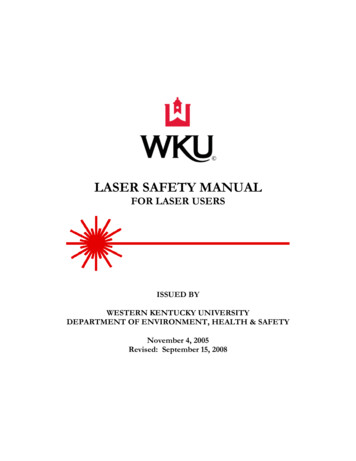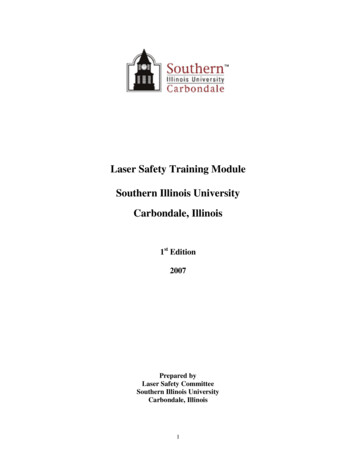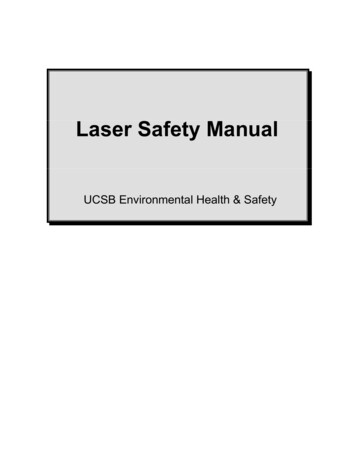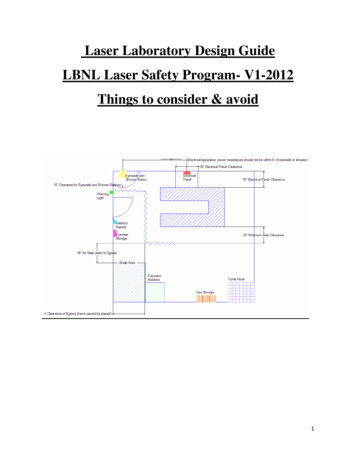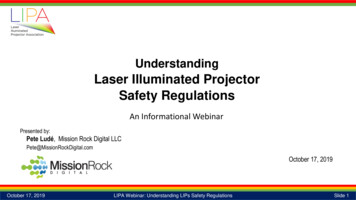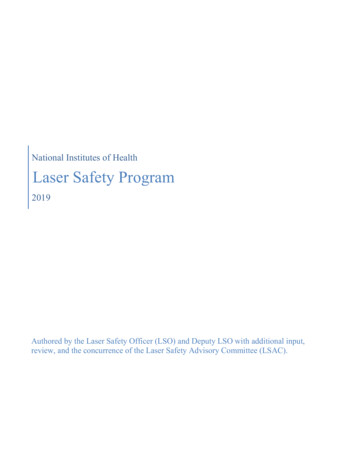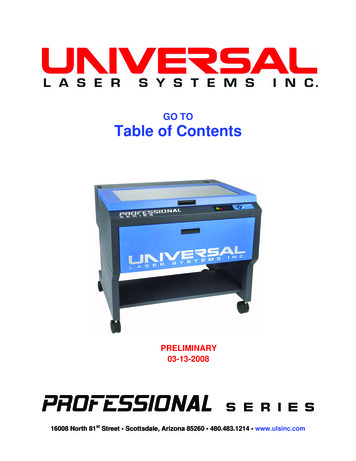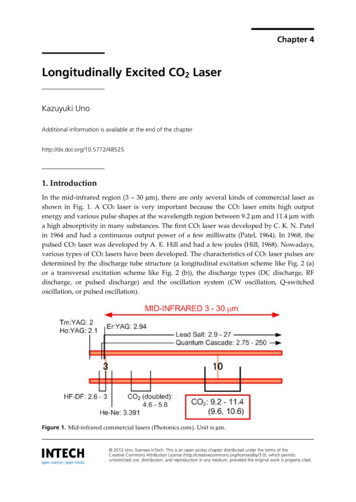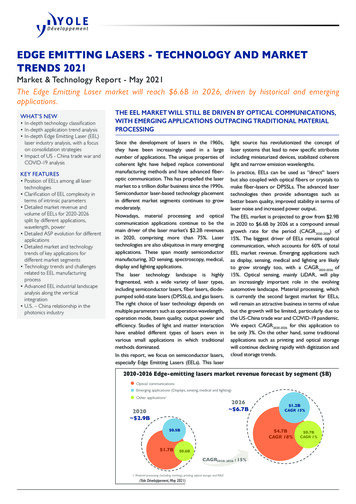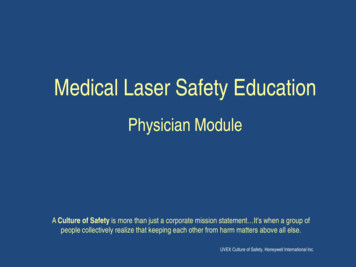
Transcription
Medical Laser Safety EducationPhysician ModuleA Culture of Safety is more than just a corporate mission statement It’s when a group ofpeople collectively realize that keeping each other from harm matters above all else.UVEX Culture of Safety, Honeywell International Inc.
EHS Physician Medical Laser Safety Training Module and Assessment TestThe material presented within is provided solely as a tool for physicians who have obtained approved laserprivileges within Elliot Health Systems (EHS), for re-training of laser SAFETY material only. It is notintended to be used as a substitute for initial laser training, training in the use of any laser system, ortraining for the delivery of laser energy. This material has been approved by a review group of the EHSLaser Safety Committee.There is a 20-question assessment test in four slides at the of this training module, slides 44, 45, 46 and47. Please submit your answers for the assessment test to the Laser Safety Officer (LSO). Instructions tosubmit the assessment are in the final slide of this presentation.
How Lasers WorkAbout Laser EnergyLight is electromagnetic energy; it is a radiant energy on the electromagnetic spectrum.Visible light is only part of the electromagnetic spectrum. Ultraviolet light radiation is anexample of light energy most people are familiar with, as well as x-ray radiation andmicrowave radiation.The acronym LASER is the process by which one form of energy is converted into anorganized light energy.The Light of the electromagnetic spectrum isAmplified whenStimulated by theEmission ofRadiation; it then becomes an organized form of energy.NOTE: Laser radiation is not ionized or mutagenic like x-ray radiation, and there are nomaximum exposure limits.
How Lasers WorkComponents of LightElectromagnetic spectrum: The range of all frequencies of electromagneticradiation, from Gamma Rays to Radio WavesVisible Light SpectrumGamma RayX-ray UltravioletX-ray and Gamma Raysemit ionizing radiation(mutagenic)Short WavelengthInfraredMicrowavesRadioMost LasersLasers emit non-ionizing radiation(non-mutagenic)Long WavelengthMost healthcare laser system wavelengths operate within the range of 200-10,600 nm on theelectromagnetic spectrum of light radiation.
How Lasers WorkComponents of LightComponents of laser light are described in the following terms:1. Wavelength – distance between repeating units of wave form2. Amplitude – height of the wave crest3. Frequency – number of wave peaks per secondWavelengthAmplitudeFrequencytimetime
How Lasers WorkLaser Light CharacteristicsLaser light has the following characteristics which are specific to lasers:Monochromatic– Laser energy produces highly purified color of light. Laser energy iscomposed of photons that emit the same color and wavelength.Collimated– Light beams are parallel, travel together tightly in one direction, and do notdiverge significantlyCoherent– Light waves travel in phase, in the same direction in an orderly manner. Allpeaks and troughs move in synchrony with each other in time and space.Compared to Ordinary Light:Multiple colors in visible light spectrumLight Not CollimatedLightNot Coherent
How Lasers WorkBasics of a Laser SystemThe medium of a laser consists of a solid, liquid, gas, or diode. The laser name usually includes the typeof medium (CO2, Holmium, Argon, etc.).LaserOptical ResonatorCavityMedium(ex. CO2, Holmium, Argon)High ReflectanceMirror (HR)Excitation Mechanism – ElectricityInactiveOutputApertureOutput CouplerPartially TransmissiveMirror (OC)LaserOptical ResonatorCavityHigh ReflectanceMirror (HR)Excitation MechanismActivatedOutputBeamOutput CouplerPartially TransmissiveMirror (OC)When activated, electrons become excited then return to their lower energy state. During transition to a lowerenergy state, a photon of light energy is emitted. This stimulates a chain reaction with other electrons, withmore photons emitted. Light photons reflect off the mirrors, align with each other, and become coherent.They are then emitted through the aperture of the output mirror, as a single coherent beam.
Laser Energy ConceptsLaser Energy Terminology Active Laser Medium: Material which is stimulated by energy from theexcitation mechanism, converts this energy with resultant emission of coherentradiation of laser energy. Energy: Capacity for doing work; output from lasers is generally expressed in joules. Joule (J): Unit of energy which describes power of energy delivery over timedduration of delivery: 1 joule 1 watt x 1 second Watt (W): The power of a laser is measured in watts: 1 W 1 joule /1 second Hertz (Hz): Unit of Frequency – cycles per second. 1 Hz 1 cycle per second Power: Rate of energy delivery, expressed in watts (W). Power Density: Amount of power that is concentrated into a spot. PowerDensity Watts/cm2
Laser Energy ConceptsLaser EnergyPower density (irradiance) – power per unit area upon a surface (spot size),usually expressed in Watts/cm2 Power density is an important factor in the application of laser energy andimpacts the laser’s effect on the tissue (i.e. vaporize, cut, coagulate)10 wattsSpot size 1.08 mmPower at 10 wattsPower Density 941 W/cm2Spot size 1.08 mmPower at 10 wattsPower Density 941 W/cm210 wattsPower Density941At same energy levelPower Densitydecreasesto only 246 when spotsize is enlarged40 watts10 wattsPower Density941To maintain similarPower Density level(983) the energy levelmust increased-in thiscase from 10 to 40 WSpot size 2.12 mmPower at 10 wattsPower Density 246 W/cm2Spot size 2.12 mmPower at 40 wattsPower Density 983 W/cm2The larger the spot, the greater the power setting required to maintain the same power density (irradiance).In this example based on CO2 power settings, for the larger spot it will take 40 watts to achieve a power densityclose to the power density achieved with 10 watts for the smaller spot sizeWhen switching from a larger spot size to a smaller spot size, if the energy remains the same the power densitywill be greater - as well as the effect on tissue.
Laser Energy ConceptsLaser EnergyThe spot size of a laser beam can be adjusted by changing the distance ofthe delivery device to the target tissue. A spot size can also be adjusted withthe use of accessory equipment with a lens which can focus or defocus thelaser beam on the target. An accessory lens can focus the laserbeam to hit the tissue at its intendedfocal point, or smallest diameter,dependent on the size of the lens thatLaser Deliveryis used.SystemLensBeam An accessory lens can also defocusthe beam, increasing the diameter ofthe spot sizeFocusing the beam increases intensity of the laser beam, useful in cutting tissueDefocusing the beam reduces laser beam intensity, used in ablating tissueBeam onTargetTissue
Laser Energy ConceptsLaser Light Energy – ReflectionThe energy of the laser beam, when directed at a surface, can result in:EnergyReflectionSpecularReflection:Angle of reflectionis equal to angle ofoncoming beamDiffuseReflection:Light reflected butbeam reflection isdispersed fromirregular angles ofsurfaceEnergyAbsorptionEnergyScatterLaser energy absorbedby tissue, creatingthermal changesEnergyTransmissionTissue can causebeam to scatter andweaken, canbackscatter into anendoscope,resulting in damageto optics and scopeBeam can passthrough certaintissue with nothermal effectuntil reachingtarget tissue(example –through sclera toretina)
Laser Energy ConceptsLaser Light Energy - ReflectionYour vision is precious – protect it! NEVER look directly into any laser beam!Never aim the beam at anything other than the intended target tissue!Direct (primary) Intrabeam viewingThis viewing is most hazardousSpecularly reflected (secondary) Intra-beam viewingBeam from a curved surface reflectorLASERLASERCURVEDMIRRORAlways UseAppropriateLaser ProtectiveEyewearLASERExtended source viewingNormally diffuse reflection, hazardous withvery high power Class IV lasersLASERFLATMIRRORSpecularly reflected (secondary) Intra-beam viewingBeam from a flat surface
Laser Energy ConceptsBio-Effects of Laser – Depth of PenetrationThe depth of tissue penetrationdepends on several factors: Laser wavelength Chromophore, color andconsistency of tissue treated Reflectance of tissue Water content of tissue Laser power settings Duration of beam exposure Spot size of beam exposureCO2Ho:YAGArgonNd:YAG10,600 nm2100 nm532 nm1064 nmLaserBeam0.1-0.2 mm0.4-0.6 mm0.5-2 mmTissue InteractionCO2 laserenergyabsorption is notdependent ontissue color,highly absorbedby water and bysoft tissueswith high watercontentHolmium laser energyis absorbed by water.The laser creates ahigh pressure steambubble which collapseson itself creatingacoustic shock wavepressure (cavitation)which can be used tofragment stonesArgon laserenergy absorbedselectively by redor dark tissue2-6 mmNd:YAG laserenergy exhibitscolor selectivityfor darkertissues, redpigment(hemoglobin)
Laser Energy ConceptsBio-Effects of Laser - Mechanism of ActionLaser Light, Chromophores and Target Tissue:-The monochromatic characteristic of laser light is essential for selective targeting of tissuechromophores. Chromophores are molecules within tissue which have their own uniquepreferentiality to absorb certain wavelengths of light. The chromophore of the target tissue is adetermining factor in selecting a laser for treatment of that tissue. Some of the most commonlytargeted chromophores within tissue include water, hemoglobin, melanin, and tattoo ink. Whendelivering laser energy to or through the skin layer, it is important to consider the differences inskin color when determining laser of choice, delivery method, and power settings, as thedifferences in melanin content can impact delivery of energy.-Because of the relationship between monochromaticity of laser light and the chromophore ofthe target tissue, laser energy can be delivered to the target tissue after passing through tissuewithout the target chromophore. For example, the target chromophores for the 532 nm laserinclude melanin and hemoglobin, not water. This allows the laser energy of this wavelength topass through the cornea and lens without effect, and to the retina where it is absorbed.Photosensitivity:There are certain medical conditions (e.g., xeroderma pigmentosum, herpes simplex) whichmay lower the MPE threshold for biological effects in the skin, cornea, lens and retina fromexposure to ultraviolet and near ultraviolet radiation. In addition, certain chemicals, known asphotosensitizing agents, can effect an increase in skin sensitivity from ultraviolet exposure.
Laser Energy ConceptsBio-Effects of LaserLaser BeamThe depth of tissue penetration and effect of thelaser energy is highly dependent on the laserwavelength and the chromophore of the targettissue, the color and consistency of the tissue, aswell as the power of the beam, duration of beamexposure, and beam spot size.The temperature producedby the laser effects thedegree of thermal damageon the al Change100 oCVaporization, Carbonization90 – 100 oCDrying65 – 90 oCProtein Denaturization60 - 65 oCCoagulation37 - 60 oCWarmingISSUEVisual ChangeSmoke PlumePuckeringWhite/GreyBlanchingNone/Erythema
Laser Energy ConceptsBio-Effects of Laser - Length of Exposure to the TissueContinuous Wave (CW):Power 200 WContinuous wave (CW)PowerLaser beam delivers a steadystream of laser energy when the device is activated. Controllingthe duration of the energy by selecting a setting on the consoleor activating a switch is referred to as gating the continuouswave of the laserPulse Mode: 200 WGated (CW)Power 1000 WPulsedUsing the pulse mode of a laser allows theuser to set the length of the duration of the delivery of laserenergy as well as to set the length of the interval between energydelivery when the device is activated. The pulse durationdetermines the time the laser energy will be delivered, affectingthe thermal effect on tissues; decreasing the pulse duration limitsthe thermal spread to surrounding tissues. The interval betweeneach pulse allows time for tissue to cool; a longer interval timebetween pulses provides additional time for tissue to cool.Q-Switched Mode:PowerQ-switchedA pulsing technique to deliver highpeak powers in short durations to disrupt tissue, with aninterval between pulses. Because of the short duration thereis no thermal effect or spread to the surrounding tissue.Commonly used in ophthalmic cases for a photo-acousticeffect.
Laser Energy ConceptsBio-Effects of Laser - Mechanism of ActionPhotomechanical (Photoacoustic) Effect: Sudden heating causes thermal expansion; acoustic/shock waves rupture cells. Heating with evaporation of water leads to expansion and imploding of vapor bubble(cavitation effect) with resultant shock wave activity (effective on calculi).Photoablative (Disruptive) Effect: Mechanical breakdown of cells, dissociation of the molecules; tissue componentsare vaporized. No thermal diffusion.Photothermal (Thermal) Effect: Light energy of laser absorbed by target tissue and converted to heat; heating cancoagulate or vaporize tissue.Photochemical (Dissociative) Effect: Light energy is used to activate photosensitive drugs that catalyze oxidation of tissueto destroy target cells. (e.g., Photodynamic Therapy)
Laser Safety ConceptsTypes of Health Care Laser SystemsSolid State Laser: The lasing medium is distributed in a solid matrix, such as a crystal or glass.One frequently used solid matrix, YAG (yttrium aluminium garnet) is a synthetic crystal materialwhich can be doped with a laser medium such as Neodymium, Erbium or Holmium. Examples ofthese lasers are the Nd:YAG, Er:YAG and Ho:YAG lasers.Diode laser: A laser diode with an electrical current flowing through a junction of dopedsemiconductor materials. Two of the semiconductor materials used in medical lasers includeGaAlAs (gallium aluminium arsenide) and InGaAs (indium gallium arsenide).Gas Laser: Laser in which gas, sometimes in a mix with other substances, is the active medium.The CO2 (carbon dioxide), Excimer , and Argon lasers are examples of gas lasers.Dye Laser: A liquid flowing dye is the active medium in this laser, often pumped by another laser,such as Argon, Excimer, a frequency-doubled solid state laser, or a with a flash lamp. Many dyesare a fire hazard, as well as poisonous and carcinogenic, requiring additional laser safety measures.Frequency Doubled Laser: In some instances a laser beam wavelength of one frequency can bepassed through a crystal which generates a twofold increase in frequency (halving the wavelength doubling the frequency). One example is a 1064 nm wavelength Nd:YAG beam passing through aKTP (potassium titanyl phosphate) crystal with a resulting doubling in frequency emitting the 532 nmwavelength laser beam.
Laser Safety ConceptsExamples of Health Care Laser G(Greenlight)Nd:YAGWavelength (Spectrum)Various Treatment/Uses488 nm, 514 nmRemove port wine birthmarks and spider veins, eye surgery, ear surgery,photodynamic therapy(Visible – Blue/Green)10,600 nm(Infrared)650-1,550 nm(Infrared)2940 nm(Infrared)308 nm(Ultraviolet)2140 nm(Infrared)532 nm(Visible – Green)1064 nm(Infrared)Cutting/vaporizing tissue, scalpel, endoscopy, neurology procedures, dentaltreatments, dermatology treatmentsHair removal, periodontal surgery, superficial vein removal, eye surgery, tissuecoagulation and ablationRemoval of prominent veins, scalpel, red/orange tattoo removal, endoscopy,hemorrhoids, keloids, laser discectomy, prostatectomyLASIK, eye surgeries, psoriasis, endovascular, dermatology proceduresUrological procedures, orthopedic, ENT, oral and laryngeal procedures, dentalapplicationsRemoval of prominent veins, cuts tissue, red/orange tattoo removal, endoscopicsurgery, hemorrhoids, keloids, laser discectomy, prostatectomy, podiatricprocedures, pigmented lesionsTattoo removal, hair removal, condyloma acuminate, dentistry, endometrial ablation,heel spurs, hemorrhoids, neurology procedures, laser angioplasty
Laser Energy ConceptsLaser Delivery Devices Articulated arm – hollow tubes with mirrors at each moveable joint to reflect anddirect laser beam in desired path: i.e. CO2 (10,600 nm) Flexible fibers – fiber core ‘light tunnel’ with reflective inner cladding to increaseinternal reflection, with protective outer jacket: i.e. Excimer (308 nm), Argon (514nm), Purepoint (532 nm), Greenlight (532 nm), Evolve (980/1470 nm), Holmium(2100 nm), CO2 (10,600 nm) Micromanipulator – mirrored device attaches to laser and microscope, allowsphysician to manipulate laser beam for line-of-sight delivery with adjustment ofmirror : i.e. CO2 (10,600 nm) Laparoscope – i.e. CO2 (10,600 nm) Laser Indirect Ophthalmoscope – i.e. Argon (514 nm), Purepoint (532 nm), Iridex(810 nm)
Laser Energy ConceptsLaser Delivery DevicesA laser delivery device is the mechanism which is manipulated to direct the laserenergy to its intended target. Delivery devices vary in styles and structure,dependent upon laser type and intended treatment.Accessories may be used with the laser or delivery device, which can include lenses,filters, connectors, tips, and couplers.Laser delivery devices and accessories may fail due to damage, misalignment,mechanical issue or fiber breakage. Failure of laser delivery devices increaserisk for laser hazards, including unintended laser beam exposure injuries and fire.The laser delivery device and accessories can effect the power density of the laserbeam delivered and the resultant effect on tissue.A surgeon has the responsibility to select the laser delivery system, power settingsand accessories appropriate for the procedure to be performed, and only thoselaser systems for which the physician has training and is credentialed.
Laser Energy ConceptsLaser Delivery DevicesTechnology has advanced withdevelopment of various types of opticalfibers for specific laser systems to alloweffective delivery of laser energy alongflexible fibers and probes to the targettissue. This allows more precise accessto areas of the body not reached by directline-of-site laser delivery.OutercladdingLaser FiberInner CladdingLaser BeamCoreReflective innerCladdingOuter CladdingInternally ReflectedLaser Beam
Laser Energy ConceptsLaser Delivery DevicesLasers used in dermatologic treatment have multiple delivery devices allowing fortreatment of a variety of skin conditions, including:facial veinsrosaceavitiligopruritusred spotsvascular birthmarksatopic dermatitisalopecia areatareduction of scarspsoriasis of skin, hair and nailsreduction of wrinkles and fine linesMany of these specially designed handpieces may be used with systems which cool theepidermis to prevent collateral damage to epidermal structures from laser light intended totarget deeper structures.
Laser Energy ConceptsLaser Delivery DevicesThe CO2 laser hasmultiple deliverydevices andaccessoriesMicromanipulatorattaches to CO2laser arm andmicroscopeAttach to laser armMicromanipulatorThese handpieces, scopeand micromanipulator aresome of the types ofdelivery devices for a widevariety of specialty laserapplicationsMirror reflectslaser beamArm manipulatesmirror for directionof laser beam totarget tissue
Laser Safety ConceptsLaser ClassificationFDA: The Food and Drug Administration’s (FDA) Center for Devices and Radiologic Health regulates all laserproducts. Four major hazard classes (1 to 4) of lasers are recognized by the FDA, with three subclasses (2a, 3a,and 3b). The higher class indicates the higher potential to pose serious danger if used improperly. Laws, regulations, and standards require engineering controls and communication of risk to aid in themanagement of hazards associated with each laser class. The Federal Laser Product PerformanceStandard (FLPPS), Code of Federal Product Regulation, requires manufacturers to provide informationon laser data including class, operation, calibration, hazards, and maintenance. All laser products in theUnited States must comply with the FLPPS.ANSI:The American National Standard Z136 is a series publications regarding laser safety standards. TheAmerican National Standard for Safe Use of Lasers in Health Care (ANSI Z136.3), part of this series, isstandard that applies to the use of health care laser systems (HCLS), written to provideaspecific processes to achieve the safe use of HCLS in various treatment settings.OSHA: Occupational Safety and Health Administration (OSHA), recognizes ANSI laser standards, requires thatall organizations using lasers have a Laser Safety Program that meets the requirements of the ANSIStandard.IEC:International Electrotechnical Commission. International Standards and Conformity Assessment for allelectrical, electronic and related technologies. International standards which apply to the manufactureand use of lasers have not been adopted by the United States, though lasers classified and labeled inaccordance with IEC may be sold in the United States.
Laser Safety ConceptsLaser ClassificationLASER LASERCLASS CLASSFDAIEC111M2a, 23a22MLASER PRODUCT HAZARDPRODUCT EXAMPLESConsidered non-hazardous. Hazard laser printersincreases if viewed with optical aids, including CD players DVD playersmagnifiers, binoculars, or telescopes.Hazard increases when viewed directly forlong periods of time. Hazard increases ifviewed with optical aids. bar code scannersPROCEDURAL ANDADMINISTRATIVECONTROLS1NOTREQUIRED1M REQUIRED2NOTREQUIREDLASERTRAINING1LASER LICATION1M DEPENDENT 1M DEPENDENT22NOTREQUIREDNOTREQUIRED2M REQUIREDAPPLICATIONAPPLICATION2M DEPENDENT 2M DEPENDENT3RNOTREQUIRED3RNOT3R NOTREQUIREDREQUIRED3BREQUIRED3BREQUIRED 3BREQUIREDlaser light show projectorsindustrial lasersImmediate skin hazard and eye hazard fromresearch lasersexposure to either the direct or reflected3Blasers used to perform LASIK eyebeam; may also present a fire hazard.surgery Health Care Laser SystemsREQUIRED3BREQUIRED 3BREQUIRED3RDepending on power and beam area, can bemomentarily hazardous when directly viewedor when staring directly at the beam with an laser pointersunaided eye. Risk of injury increases whenviewed with optical aids.3BImmediate skin hazard from direct beam and industrial lasersimmediate eye hazard when viewed directly. research lasers laser light show projectors3b Health Care Laser Systems44
Laser Safety ConceptsLaser Hazards – Hazard ZonesMaximum Permissible Exposure (MPE):The level of laser light radiationone may be exposed to without risk for laser hazards, injury, or adverse changes of theeye or skin.Nominal Hazard Zone (NHZ): The calculated laser treatment area in which laserexposure presents a risk for hazards, injury and/or adverse changes of the eye and skin.Within this area the direct, reflected, or scattered laser radiation during normal laser operationexceeds the maximum permissible exposure (MPE), increasing risks. Control measures andsafety precautions are REQUIRED within the NHZ.Outside the designated laser treatment area (beyond the NHZ) there is no risk forlaser exposure injury (laser exposure is below the MPE).To avoid the need for laser barrier curtains and calculation of nominal hazard zonewithin a treatment area, it is acceptable to designate the entire room where the laserprocedure is conducted as the NHZ; HOWEVER, all windows and entryways mustbe blocked to contain the laser beam within the NHZ, as many lasers can transmitlong distances and through glass.
Laser Safety ConceptsLaser Hazards – Hazard ZoneVISIBLE AND INVISIBLE LASER RADIATIONAVOID EYE OR SKIN EXPOSURE TODIRECT OR SCATTERED RADIATIONHOLMIUM:YAG 2.1 μm, 5 J Max, 600 μspulseNd:YAG: 1064 nm, 2 J Max, 2.0 ms pulseDiode Laser: 650 nm, 5 mW, Max CWEYE PROTECTION REQUIREDCLASS IV LASER PRODUCT per 21 CFR 1040 Warning signs shall be posted at every entry to alaser treatment controlled area. Information shallinclude the appropriate warning for laser class inuse (Danger or Caution), type of laser, wavelengthemitted, maximum output, and class of laser.Warning signs shall be covered or removed whenlaser is not in use. Restrict treatment area access (Nominal HazardZone) to appropriate personnel. Appropriate wavelength specific safety eyewear,with information printed on eyewear, shall beavailable at each main entry to a laser treatmentarea.
Laser Safety ConceptsLaser Hazards – Unintentional Laser Beam ExposureUnintentional laser beam exposure and injury can be caused by: Failure to take appropriate laser safety precautions (signage, moist drapes,standby mode, etc.) Failure to use appropriate laser safety items (protective eyewear, barriers, etc) Non-adherence to standard operating procedures during alignment andoperation Equipment failure (broken laser fiber, mirror, etc.) Insufficient training or untrained personnel in laser use area Improperly functioning laser and/or laser accessories Failing to take necessary precautions to contain laser beam and reflectionwithin the nominal hazard zone (window barriers, nonreflective instruments,etc.)The laser user should be the only one to activate laser device.Place laser in standby mode when not actively performing treatment.Place laser footplate convenient to laser user and separate from otherfootplates (i.e. electrocautery, x-ray)
Laser Safety ConceptsLaser Hazards – Unintentional Laser Beam ExposureSkin Exposure Biological Effects: Erythema, skin cancer, accelerated skinaging, increased pigmentation, pigment darkening, skin burn,photosensitive reactionsEye Exposure Biological Effects: Photokeratitis, photochemical andthermal retinal injury, retinal burn, corneal burn, aqueous flare, cataractformationALWAYS USE APPROPRIATE LASER PROTECTIVE EYEWEAR FOR EVERYONE IN THELASER TREATMENT AREA - YOURSELF, YOUR PATIENT AND YOUR TEAMAll laser protective eyewear is labeled for use with specific laser wavelength(s). Some are labeledonly for one wavelength, others are labeled and appropriate for a range of wavelengths. Always checkand use the eyewear specific to the laser wavelength in use. Patient eye protection can include laserprotective eyewear or eye shields.Optical Density (OD) is the blocking ability of an optical filter, the measurement of the extent to whicha substance allows light to filter through. All laser protective eyewear (LPE) must be label with theoptical density as well as laser wavelength for which it is appropriate.The wavelength of the laser output is the most important factorin determining the type of eye protection to be used.
Laser Safety ConceptsLaser Hazards – Unintentional Laser Beam Exposure - 30003000-106MACULALENSEye StructureInjuryCorneal BurnCorneal BurnCorneal BurnAqueous FlareCorneal BurnWavelength (nm)315-400780-14001400-3000FOVEAEye le CataractRETINAWavelength(nm) Eye StructureInjury400-780780-1400Photochemicaland ThermalRetinal Injury,ScotomaRetinal BurnAlways Use Appropriate Laser Protective Eyewear for Patient and TeamUltraviolet Keratitis /Photokeratitiscorneal flash burn (also calledwelder’s flash or snowblindness) can be considered tobe a sunburn of the eye surface.Cataract-clouding of the lensin the eye that results inblurred vision. Can resultfrom continual low powerexposure to the laser beam.Scotoma-blind spot in the field ofvision, on the fovea. Caused by directexposure to the laser beam to retina.Retinal injuries-more likely to bepermanent, including reduced visionor blindness.
Laser Safety ConceptsLaser Hazards – Airway Specific HazardsProcedures in and around the airway require additional safety measures to prevent and manage airway fires.Endotracheal tubes (ETT) made of polyvinyl chloride (PVC) are extremely flammable, can be ignited by alaser beam, and will support combustion.Take precautions to prevent airway fire: Use endotracheal tube made specifically for laser procedure & specific to laser wavelength in use Use lowest possible concentration of oxygen for laryngeal/tracheal procedures, try to limitoxygen concentration to less than 30%, and prevent leaks around ETT Do not use nitrous oxide to dilute oxygen – nitrous oxide supports combustion; helium is lessdense, retards burning Use caution with equipment which can be flammable – tooth guard, face mask, suction catheters Suction around ETT and under drapes prior to laser use to remove any concentrations ofgases Remove flammable lotion, cologne, hair spray or gel from patient hair or skin If lubricant needed, use water-based lubricants around laser treatment area Avoid alcohol-based preps; if used, must have adequate dry time prior to draping Avoid pooling of flammable liquid preparations Moistened gauze or towels around treatment area may dry; keep moist to avoid risk of fire A container of water or saline must be available for immediate dousing should fire occur Emergency tracheotomy instruments/kit must be available in room for all laser airway procedures
Laser Safety ConceptsLaser Specific Endotracheal TubesLaser Tube (Rusch)with LATEXLaser-Shield II (Medtronic)CO2 (10,600 nm)and KTP (532 nm)Laser Flex (Mallinckrodt)Proven on CO2 and KTPUse endotracheal tubes made specifically for laser procedures in and around the airway andspecific to laser wavelength in use (Rusch Laser Tube, Mallinckrodt Laser-Flex, MedtronicLaser-Shield II). Always follow manufacturer recommendations (i.e. inflate with fluid, protectwith wet cottonoid)
Laser SafetyLaser Hazards - Managing Airway FireWhen an airway fire is suspected act immediately!Stop the gas flow Disconnect breathing circuit – this is the quickest way to stop the gas flow.The fire’s intensity reduces and may self-extinguish.Remove the tube from the patient Maintain airway patencyNote: The above two steps should be done as quickly and simul
Laser Safety Committee. There is a 20-question assessment test in four slides at the of this training module, slides 44, 45, 46 and 47. Please submit your answers for the assessment test to the Laser Safety Officer (LSO). Instructions to submit the assessment are in the final slide of this presentation. EHS Physician Medical Laser Safety .

